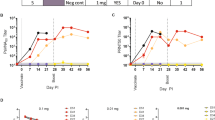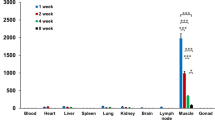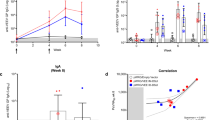Abstract
Pre-existing immunity against adenoviruses may compromise the efficacy of adenoviral vectors for vaccination and gene therapy. The purpose of this study was to determine whether encapsulation of adenovirus recombinants into biodegradable alginate microparticles could circumvent the vector-specific immune response. Mice were immunized either intranasally (i.n.) or intraperitoneally (i.p.) with human adenovirus type 5 (HAd5), resulting in the development of virus-specific antibodies. Immunized and naı¨ve mice were inoculated with AdCA36lacZ (an E1-deleted HAd5 recombinant containing the bacterial β-galactosidase (LacZ) gene), encapsulated (E) into alginate microparticles, or nonencapsulated (NE) ie, as a virus suspension. LacZ expression in animals immunized once (1×) or twice (2×) with HAd5 and subsequently inoculated with NE-AdCA36lacZ (NE-Z) was significantly (P<0.001) reduced compared to those levels observed in NE-Z inoculated naı¨ve mice, suggesting that the immune response against the vector adversely affected transgene expression. In contrast, there was only slight reduction (P>0.05) in LacZ expression in mice immunized 1× or 2× with HAd5 that were subsequently inoculated with E-AdCA36lacZ (E-Z) compared to those levels obtained in E-Z inoculated naı¨ve animals. Similar results were obtained with i.n. or i.p. inoculated animals. These results indicate that microencapsulation of recombinant adenovirus effectively circumvented the vector-specific immune response.
This is a preview of subscription content, access via your institution
Access options
Subscribe to this journal
Receive 12 print issues and online access
$259.00 per year
only $21.58 per issue
Buy this article
- Purchase on Springer Link
- Instant access to full article PDF
Prices may be subject to local taxes which are calculated during checkout




Similar content being viewed by others
References
Bramson JL, Graham FL, Gauldie J . The use of adenoviral vectors for gene therapy and gene transfer in vivo Curr Opin Biotechnol 1995 6: 590–595
Imler J-L . Adenovirus vectors as recombinant viral vaccines Vaccine 1995 13: 1143–1151
Alemany R, Balague C, Curiel DT . Replicative adenoviruses for cancer therapy Nat Biotechnol 2000 18: 723–727
Crystal RG . Transfer of genes to humans: early lessons and obstacles to success Science 1995 270: 404–410
Kass-Eisler A et al. Circumventing the immune response to adenovirus-mediated gene therapy Gene Ther 1996 3: 154–162
Hackett NR, Kaminsky SM, Sondhi D, Crystal RG . Antivector and antitransgene host responses in gene therapy Curr Opin Mol Ther 2000 2: 376–382
Yang Y et al. Cellular immunity to viral antigens limits E1-deleted adenovirus for gene therapy Proc Natl Acad Sci USA 1994 91: 4407–4411
Yang Y, Li Q, Ertl HC, Wilson JM . Cellular and humoral immune responses to viral antigens create barriers to lung-directed gene therapy with recombinant adenoviruses J Virol 1995 69: 2004–2015
Dai Y et al. Cellular and humoral immune responses to adenoviral vectors containing factor IX gene: tolerization of factor IX and vector antigens allows for long term expression Proc Natl Acad Sci USA 1995 92: 1401–1405
Kafri T et al. Cellular immune response to adenoviral vector infected cells does not require de novo viral gene expression: implications for gene therapy Proc Natl Acad Sci USA 1998 95: 11 377–11 382
Dong JY et al. Systemic analysis of repeated gene delivery into animal lungs with a recombinant adenovirus vector Hum Gene Ther 1996 7: 319–331
Walter J et al. Successful expression of human factor IX following repeat administration of an adenoviral vector in mice Proc Natl Acad Sci USA 1996 93: 3056–3061
Moffatt S, Hays J, HogenEsch H, Mittal SK . Circumvention of vector-specific neutralizing antibody response by alternating use of human and non-human adenoviruses: implications in gene therapy Virology 2000 272: 159–167
Chirmule N et al. Immune responses to adenovirus and adeno-associated virus in humans Gene Ther 1999 6: 1574–1583
Harvey BG et al. Variability of human systemic humoral immune responses to adenovirus gene transfer vectors administered to different organs J Virol 1999 73: 6729–6742
Smith TA, White BD, Gardner JM, Kaleko M, McClelland A . Transient immunosuppression permits successful repetitive intravenous administration of an adenovirus vector Gene Ther 1996 3: 496–502
Kaplan JM, Smith AE . Transient immunosuppression with deoxyspergualin improves longevity of transgene expression and ability to readminister adenoviral vector to the mouse lung Hum Gene Ther 1997 8: 1095–1104
Ilan Y et al. Transient immunosuppression with FK506 permits long-term expression of therapeutic genes introduced into the liver using recombinant adenoviruses in the rat Hepatology 1997 26: 949–956
Guerette B et al. Prevention of immune reactions triggered by first-generation adenoviral vectors by monoclonal antibodies and CTLA4Ig Hum Gene Ther 1996 7: 1455–1463
Jooss K, Turka LA, Wilson JM . Blunting of immune responses to adenoviral vectors in mouse liver and lung with CTLA4Ig Gene Ther 1998 5: 309–319
O'Riordan CR et al. PEGylation of adenovirus with retention of infectivity and protection from neutralizing antibody in vitro and in vivo Hum Gene Ther 1999 10: 1349–1358
Croyle MA, Yu QC, Wilson JM . Development of a rapid method for the PEGylation of adenoviruses with enhanced transduction and improved stability under harsh storage conditions Hum Gene Ther 2000 11: 1713–1722
Fisher K, Stallwood Y, Ulbrich K, Mautner V, Seymour L . Protection and retargeting of adenovirus using a multifunctional hydrophilic polymer Mol Ther 2000 1: S57
Douglas JT et al. Targeted gene delivery by tropism-modified adenoviral vectors Nat Biotechnol 1996 14: 1574–1578
Bilbao G, Gomez-Navarro J, Curiel DT . Targeted adenoviral vectors for cancer gene therapy Adv Exp Med Biol 1998 451: 365–374
Douglas JT et al. A system for the propagation of adenoviral vectors with genetically modified receptor specificities Nat Biotechnol 1999 17: 470–475
Nicklin SA et al. Ablating adenovirus type 5 fiber-CAR binding and HI loop insertion of the SIGYPLP peptide generate an endothelial cell-selective adenovirus Mol Ther 2001 4: 534–542
Kim J et al. Targeting adenoviral vectors by using the extracellular domain of the coxsackie-adenovirus receptor: improved potency via trimerization J Virol 2002 76: 1892–1903
Bowersock TL, Hogenesch H . Oral immunization using microparticles In: Park K (ed) Controlled Drug Delivery Challenges and Strategies American Chemical Society: Washington 1997 pp 269–288
Bowersock TL et al. Oral vaccination of animals with antigens encapsulated in alginate microspheres Vaccine 1999 17: 1804–1811
Periwal SB, Speaker TJ, Cebra JJ . Orally administered microencapsulated reovirus can bypass suckled, neutralizing maternal antibody that inhibits active immunization of neonates J Virol 1997 71: 2844–2850
Hilbert AK, Fritzsche U, Kissel T . Biodegradable microspheres containing influenza A vaccine: immune response in mice Vaccine 1999 17: 1065–2073
Aggarwal N et al. Biodegrable alginate microspheres as a delivery system for naked DNA Can J Vet Sci 1999 63: 148–152
Mittal SK et al. Immunization with DNA, adenovirus or both in biodegradable alginate microspheres: effect of route of inoculation on immune response Vaccine 2000 19: 253–263
Kay MA et al. Long-term hepatic adenovirus-mediated gene expression in mice following CTLA4Ig administration Nat Genet 1995 11: 191–197
Guibinga G-H et al. Combinatorial blockade of calcineurin and CD28 signaling facilitates primary and secondary therapeutic gene transfer by adenovirus vectors in dystrophic (mdx) mouse muscles J Virol 1998 72: 4601–4609
Ilan Y et al. Oral tolerization to adenoviral proteins permits repeated adenovirus mediated gene therapy in rats with pre-existing immunity to adenoviruses Hepatology 1998 27: 1368–1376
Ye X et al. Transient depletion of CD4 lymphocyte improves efficacy of repeated administration of recombinant adenovirus in the ornithine transcarbamylase deficient sparse fur mouse Gene Ther 2000 7: 1761–1767
Roy S, Shirley PS, McClelland A, Kaleko M . Circumvention of immunity to the adenovirus major coat protein hexon J Virol 1998 72: 6875–6879
Mack CA et al. Circumvention of anti-adenovirus neutralizing immunity by administration of an adenoviral vector of an alternate serotype Hum Gene Ther 1997 8: 99–109
Morral N et al. Administration of helper-dependent adenoviral vectors and sequential delivery of different vector serotype for long-term liver-directed gene transfer in baboons Proc Natl Acad Sci USA 1999 96: 12 816–12 821
Parks R, Evelegh C, Graham FL . Use of helper-dependent adenoviral vectors of alternative serotypes permits repeat vector administration Gene Ther 1999 6: 1565–1573
Maione D et al. An improved helper-dependent adenoviral vector allows persistent gene expression after intramuscular delivery and overcomes preexisting immunity to adenovirus Proc Natl Acad Sci USA 2001 98: 5986–5991
Mittal SK et al. Monitoring foreign gene expression by a human adenovirus-based vector using the firefly luciferase gene as a reporter Virus Res 1993 28: 67–90
Chillon M, Lee JH, Fasbender A, Welsh MJ . Adenovirus complexed with polyethylene glycol and cationic lipid is shielded from neutralizing antibodies in vitro Gene Ther 1998 5: 995–1002
Beer SJ et al. Poly (lactic-glycolic) acid copolymer encapsulation of recombinant adenovirus reduces immunogenicity in vivo Gene Ther 1998 5: 740–746
Lomotan EA, Brown KA, Speaker TJ, Offita PA . Aqueous-based microcapsules are detected primarily in gut-associated dendritic cells after oral inoculation of mice Vaccine 1997 15: 1959–1962
Zhang Y et al. Acute cytokine response to systemic adenoviral vectors in mice is mediated by dendritic cells and macrophages Mol Ther 2001 3: 697–707
Addison CL, Hitt M, Kunsken D, Graham FL . Comparison of the human versus murine cytomegalovirus immediate early gene promoters for transgene expression by adenoviral vectors J Gen Virol 1997 78: 1653–1661
Graham FL, Prevec L . Adenovirus expression vectors and recombinant vaccines. In: Ellis RW (ed) Vaccines: New Approaches to Immunological Problems Butterworth-Heineman: Boston 1992 pp 363–390
Mittal SK, Middleton DM, Tikoo SK, Babiuk LA . Pathogenesis and immunogenicity of bovine adenovirus type 3 in cotton rats (Sigmodon hispidus) Virology 1995 213: 131–139
Acknowledgements
We thank Dr FL Graham, Departments of Biology and Pathology, McMaster University, Hamilton, Ontario, Canada for providing AdCA36lacZ and Jane Kovach for excellent secretary assistance. This work was supported by Public Health Service grant GM5516 from NIH/NIGMS to SKM
Author information
Authors and Affiliations
Rights and permissions
About this article
Cite this article
Sailaja, G., HogenEsch, H., North, A. et al. Encapsulation of recombinant adenovirus into alginate microspheres circumvents vector-specific immune response. Gene Ther 9, 1722–1729 (2002). https://doi.org/10.1038/sj.gt.3301858
Received:
Accepted:
Published:
Issue Date:
DOI: https://doi.org/10.1038/sj.gt.3301858
Keywords
This article is cited by
-
Engineering Biomaterial Systems to Enhance Viral Vector Gene Delivery
Molecular Therapy (2011)
-
Potentiating Cancer Immunotherapy Using an Oncolytic Virus
Molecular Therapy (2010)
-
Using viral vectors as gene transfer tools (Cell Biology and Toxicology Special Issue: ETCS-UK 1 day meeting on genetic manipulation of cells)
Cell Biology and Toxicology (2010)
-
Viral vector-based prime-boost immunization regimens: a possible involvement of T-cell competition
Gene Therapy (2008)
-
Recent progress in the battle between oncolytic viruses and tumours
Nature Reviews Cancer (2005)



